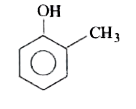p-Chlorobenzoic acid can be prepared by reacting p-aminobenzoic acid with
HCl
Cu2Cl2
Cl2 in presence of AlCl3
HNO(2), followed by hot solution of Cu2Cl2.
The correct Answer is:D
To prepare p-chlorobenzoic acid from p-aminobenzoic acid, we can follow these steps:
1. Identify the Starting Material: We start with p-aminobenzoic acid, which has the structure:
- Benzene ring with an amino group (-NH2) at the para position relative to the carboxylic acid group (-COOH).
2. Understand the Reaction: The goal is to replace the amino group (-NH2) with a chlorine atom (-Cl) to form p-chlorobenzoic acid.
3. Use of HNO2: The first step involves treating p-aminobenzoic acid with nitrous acid (HNO2). This reaction leads to the formation of a diazonium salt:
- The amino group (-NH2) is converted to a diazonium group (-N2+), resulting in the formation of p-diazobenzenecarboxylic acid.
4. Formation of Diazotization Product: The reaction can be represented as:
- p-aminobenzoic acid + HNO2 → p-diazobenzenecarboxylic acid (with -N2+ group).
5. Use of Cu2Cl2: The next step is to treat the diazonium compound with a hot solution of copper(I) chloride (Cu2Cl2):
- The diazonium group (-N2+) is replaced by a chlorine atom (-Cl) in a reaction known as the Sandmeyer reaction.
6. Final Product Formation: The final product after the reaction is p-chlorobenzoic acid, which has the structure:
- Benzene ring with a carboxylic acid group (-COOH) and a chlorine atom (-Cl) at the para position.
Conclusion:
The correct reagent to convert p-aminobenzoic acid to p-chlorobenzoic acid is HNO2 followed by hot Cu2Cl2.
- Benzene ring with an amino group (-NH2) at the para position relative to the carboxylic acid group (-COOH).
- The amino group (-NH2) is converted to a diazonium group (-N2+), resulting in the formation of p-diazobenzenecarboxylic acid.
- p-aminobenzoic acid + HNO2 → p-diazobenzenecarboxylic acid (with -N2+ group).
- The diazonium group (-N2+) is replaced by a chlorine atom (-Cl) in a reaction known as the Sandmeyer reaction.
- Benzene ring with a carboxylic acid group (-COOH) and a chlorine atom (-Cl) at the para position.
The correct reagent to convert p-aminobenzoic acid to p-chlorobenzoic acid is HNO2 followed by hot Cu2Cl2.
Topper's Solved these Questions
- AROMATIC COMPOUNDS BOOK - RESONANCE ENGLISHCHAPTER - AROMATIC COMPOUNDS EXERCISE - PART-III: PRACTICE TEST-2(IIT-JEE(ADVANCED pattern))
7 Videos
- AROMATIC COMPOUNDS BOOK - RESONANCE ENGLISHCHAPTER - AROMATIC COMPOUNDS EXERCISE - Section -2 (one or more than one options correct type)
7 Videos
- AROMATIC COMPOUNDS BOOK - RESONANCE ENGLISHCHAPTER - AROMATIC COMPOUNDS EXERCISE - PART-I PRACTICE TEST-1(IIT-JEE MAIN PATTERN)
30 Videos
- ATOMIC STRUCTUREBOOK - RESONANCE ENGLISHCHAPTER - ATOMIC STRUCTUREEXERCISE - ORGANIC CHEMISTRY(Fundamental Concept )
16 Videos
Similar Questions
Knowledge Check
Benzyl chloride can be prepared by reacting :
AToluene with Cl2 in the presence of FeCl3BBenzene with CH3Cl in the presence of AlCl3CToluene with Cl2 in the presence of sunlightDBenzene with Cl2 in the presence of FeCl3Benzoic acid may be prepared by the oxidation of :
A B
B C
C D
D
Acid anhydride can be prepared by :
AC6H5COOH+CH3COClpyridine−−−−→BC6H5COO−Na++C6H5COCl→CC6H5CONH2+CH3COO−Na+→D
Fluorine is more electronegative than chlorine but p-fluorobenzoic acid is a weaker acid than p-chlorobenzoic acid. Explain.
View SolutionThere is a solution of p-hydroxybenzoic acid and p-amino benzoic acid . Discuss one method by which we can separate them and also write down the confirmatory test of the functional groups present .
View SolutionFormic acid is prepared by heating oxalic acid with
View SolutionFormic acid is prepared by heating oxalic acid with
View SolutionFormic acid is prepared by heating oxalic acid with
View Solution
